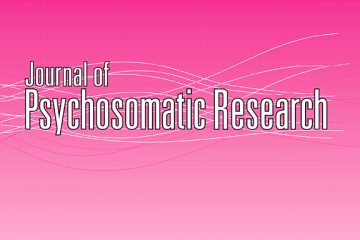The Editor’s choice March 2022
written by Jess G. Fiedorowicz, Editor-in-Chief, Journal of Psychosomatic Research, Professor and Senior Research Chair in Adult Psychiatry, University of Ottawa, Head and Chief of Mental Health, The Ottawa Hospital Scientist, Ottawa Hospital Research Institute, March 2022 and Antonina Mikocka-Walus, Deputy Editor, Journal of Psychosomatic Research .

Jess Fiedorowicz, JPR’s Editor-in-Chief
The Editor’s Choice –
Identified Pathology Does not Impact Prognosis of Neurological Disorders
This quarter’s Editor’s Choice article contrasts 12-month prognosis of patients referred to neurology clinics between those who had recognized pathophysiology or were deemed to have functional neurological disorders. There are several important clinical and advocacy take home messages from this article that warrant promotion with Editor’s Choice recognition. The selected paper analyzes baseline data from >2500 new neurology outpatients who participated in the Scottish Neurological Symptom Study (SNSS), a prospective, multi-centre cohort study in Scotland (1). From this sample 716 were classified as functional and 1865 as pathophysiological. The outcomes of each group at 12 months were nearly identical. Prediction models using deep neural networks training on 92 baseline features were not able to accurately predict outcome with an area under the receiver-operator curve of 0.67.
The medical community clearly treats those who present with symptoms with and without an explainable medical etiology quite differently. With regard to neurological symptoms, research has largely focused on nonepileptic seizures. Those without an identifiable medical etiology, sometimes called functional neurological symptoms, bear a considerable stigma (2) and even discrimination (3). Yet, these groups so segregated by the medical establishment have similar burdens from their illness (4). In this 12-month prospective cohort, they also have a strikingly similar prognosis. Based on change as measured by the Clinical Global Improvement scale, those with functional disorders were just as likely to experience improvement (32% vs. 34%), to remain unchanged (48% vs. 48%), or to worsen (19% vs. 18%). These are strikingly similar percentages which were not statistically significant (p=.52) even in this large sample.
The study sample is its clear strength: the cohort is representative of those receiving outpatient neurological care in Scotland across multiple centers. A total of 3,781 outpatients were recruited between 2002 and 2004. At baseline, the extent to which patients’ symptoms were attributable to an “organic” cause was assessed on a 4-point Likert scale. For the current analysis, these four categories were lumped into two: not at all/somewhat and largely/completely. For a clinical sample of this size, participants had a fairly comprehensive assessment at baseline, which included sociodemographic information, anxiety and depressive symptoms, health-related quality of life, sexual/menstrual symptoms, neurological symptoms, illness beliefs, illness experience, and causal attribution. The authors had at their disposal a large, reasonably well-characterized clinical sample in this prospective cohort.
Follow-up assessments were conducted at three and twelve months. The primary clinical outcome for this analysis was self-reported Clinical Global Improvement (much worse/worse/not changed/better/much better) at 12 months. As previously reported, the groups did not differ on this measure and were essentially indistinguishable. The authors also created models in attempt to predict outcomes from baseline variables using multiple methods, including deep neural networks. Models had quite limited predictive utility (AUC’s of 0.6-0.7) with older age, disease burden, and negative expectations as common predictors of outcome in both groups.
The work of Shipston-Sharmon and colleagues is a meaningful addition to a literature that should cause the broader medical community to rethink our approach to functional neurological disorders. These conditions can present across a full range of neurological symptoms but are more distressing and disabling than their medically explained counterparts. In a large, representative clinical sample, Shipston-Sharmon et al. show that while prognosis appears identical, and outcome is not easily predicted, the levels of anxiety and depression symptoms, quality of life and symptom burden are greater than in those with pathophysiological disorders. Functional neurological disorders can and should be treated with the appropriate resources, yet too often these patients are dismissed, even mistreated as they attempt to seek care for their condition. Often, they may not even have experienced a straightforward discussion of their diagnosis or prognosis. We must advocate, as others more eloquently have (5), for a healthcare system that provides these patients the interdisciplinary care and treatment they deserve, but too often remains reserved for those with identifiable etiologies and is out of reach.Seitenumbruch
References
- Shipston-Sharman O, Popkirov S, Hansen CH, Stone J, Carson A. Prognosis in functional and recognised pathophysiological neurological disorders – a shared basis. J Psychosom Res. 2021;152:110681.
- MacDuffie KE, Grubbs L, Best T, LaRoche S, Mildon B, Myers L, et al. Stigma and functional neurological disorder: a research agenda targeting the clinical encounter. CNS Spectr. 2020:1-6.
- Rawlings GH, Reuber M. Health care practitioners’ perceptions of psychogenic nonepileptic seizures: A systematic review of qualitative and quantitative studies. Epilepsia. 2018;59(6):1109-23.
- Carson A, Stone J, Hibberd C, Murray G, Duncan R, Coleman R, et al. Disability, distress and unemployment in neurology outpatients with symptoms ‘unexplained by organic disease’. J Neurol Neurosurg Psychiatry. 2011;82(7):810-3.
- Edwards MJ. Functional neurological disorder: an ethical turning point for neuroscience. Brain. 2019;142(7):1855-7.

See this link fyi; https://www.sciencedirect.com/science/article/pii/S0022399921003020



0 Comments